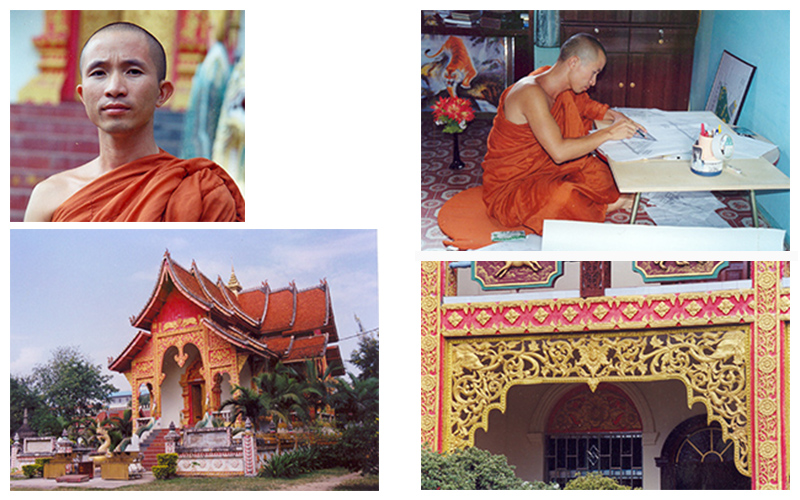
Ma Hazhuang – Dai Engraver in Jinghong City, Xishuangbanna
Maha Zhuang (玛哈庄) is a renowned Dai carving artist from Xiaojie Township (小街乡), Jinghong City (景洪市), Xishuangbanna Dai Autonomous Prefecture (西双版纳傣族自治州). His exquisite carvings enjoy great prestige locally and have significantly influenced the entire Xishuangbanna region.

Guardians of Wood and Stone
Dai carving (傣族雕刻), an ancient art form originating from Xishuangbanna (西双版纳) and Dehong (德宏) regions, represents one of Yunnan’s most exquisite intangible cultural heritages. For centuries, Dai artisans have transformed temples, homes, and everyday objects into canvases of spiritual expression through their knives and chisels.
The Sacred and the Mundane
Dai carving primarily manifests in two forms:
- Temple carvings : Elaborate depictions of Buddhist motifs adorning wat walls, pillars, and eaves
- Household carvings : Functional art on furniture, utensils, and architectural elements
Characteristics of Dai Carving
Flowing Lines, Divine Forms
Dai carving distinguishes itself through:
- Curvilinear patterns mimicking tropical flora and fauna
- Religious symbolism featuring peacocks, elephants, and naga motifs
- Negative space mastery creating lace-like wooden screens
The Carver’s Sacred Journey
Traditional training involves:
- 7-year apprenticeships under master carvers
- Meditation before handling tools
- Ritual offerings to tree spirits when sourcing materials
Cultural Significance
Buddhism in Three Dimensions
Dai carving serves as:
- Visual scripture for illiterate devotees
- Architectural poetry transforming temples into “Buddhist storybooks”
- Community identity markers distinguishing Dai subgroups
Endangered Elegance
While once flourishing with over 200 master carvers in the 1950s, current surveys show:
- Only 17 recognized inheritors remain
- Machine-carved replicas dominate tourist markets
- UNESCO has listed Dai woodcarving as “urgently needing safeguarding”
Preservation Efforts
New Life for Ancient Knives
Recent initiatives include:
- Government-funded workshops in Jinghong (景洪) and Ruili (瑞丽)
- Digital documentation of 10,000+ traditional patterns
- “Carving in Schools” programs across 23 Dai villages
This sacred craft, balancing spiritual devotion with artistic innovation, continues its delicate dance between tradition and modernity.
For Chinese version please go to:
http://www.ynich.cn/view-ml-13111-3317.html

 7 Days GolfingTour
7 Days GolfingTour
 8 Days Group Tour
8 Days Group Tour
 8 Days Yunnan Tour
8 Days Yunnan Tour
 7 Days Shangri La Hiking
7 Days Shangri La Hiking
 11 Days Yunnan Tour
11 Days Yunnan Tour
 6 Days Yuanyang Terraces
6 Days Yuanyang Terraces
 11 Days Yunnan Tour
11 Days Yunnan Tour
 8 Days South Yunnan
8 Days South Yunnan
 7 Days Tea Tour
7 Days Tea Tour
 8 Days Muslim Tour
8 Days Muslim Tour
 12 Days Self-Driving
12 Days Self-Driving
 4 Days Haba Climbing
4 Days Haba Climbing
 Tiger Leaping Gorge
Tiger Leaping Gorge
 Stone Forest
Stone Forest
 Yunnan-Tibet
Yunnan-Tibet
 Hani Rice Terraces
Hani Rice Terraces
 Kunming
Kunming
 Lijiang
Lijiang
 Shangri-la
Shangri-la
 Dali
Dali
 XishuangBanna
XishuangBanna
 Honghe
Honghe
 Kunming
Kunming
 Lijiang
Lijiang
 Shangri-la
Shangri-la
 Yuanyang Rice Terraces
Yuanyang Rice Terraces
 Nujiang
Nujiang
 XishuangBanna
XishuangBanna
 Spring City Golf
Spring City Golf
 Snow Mountain Golf
Snow Mountain Golf
 Stone Mountain Golf
Stone Mountain Golf

















